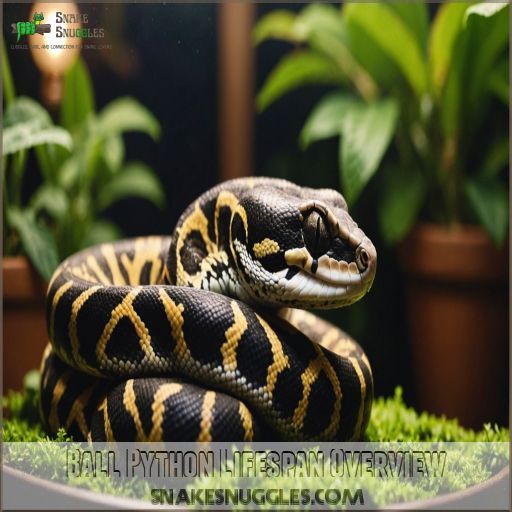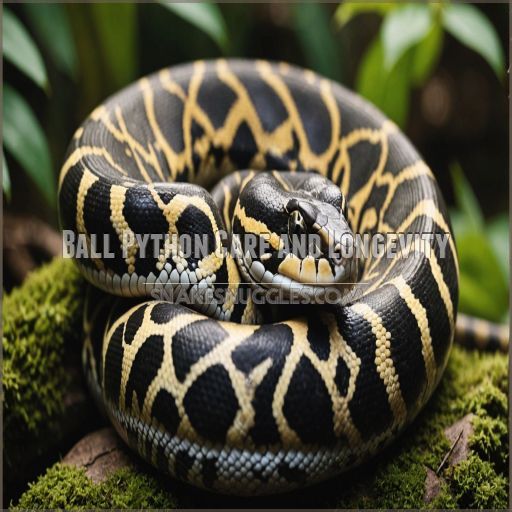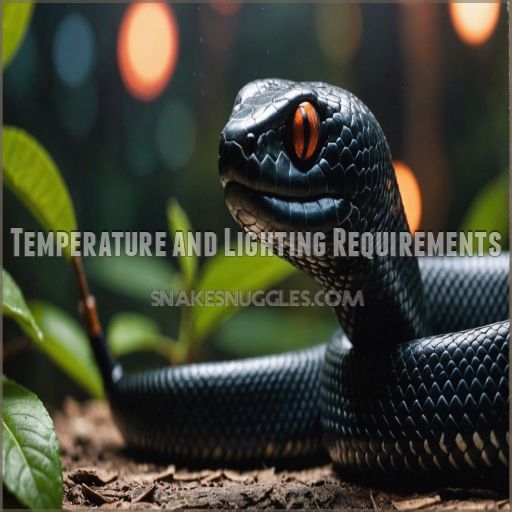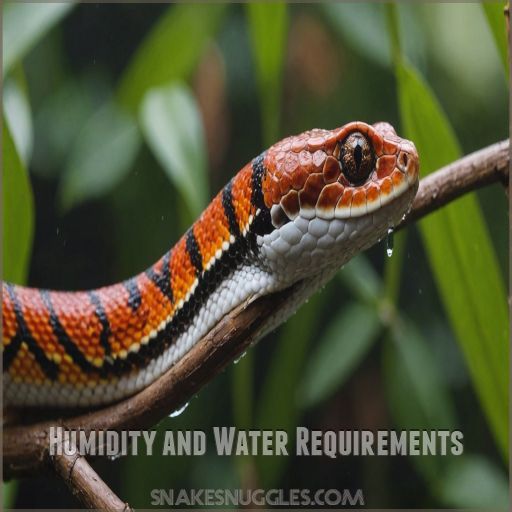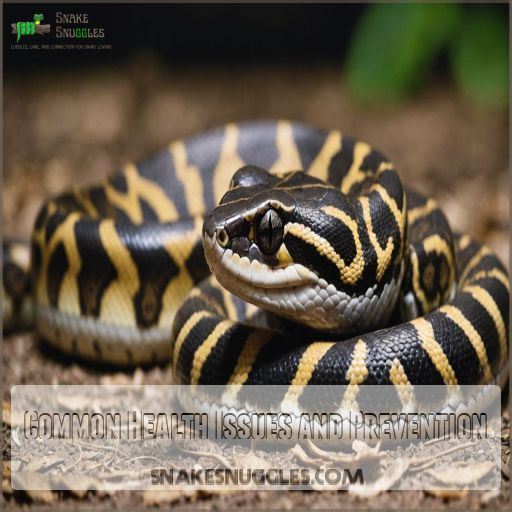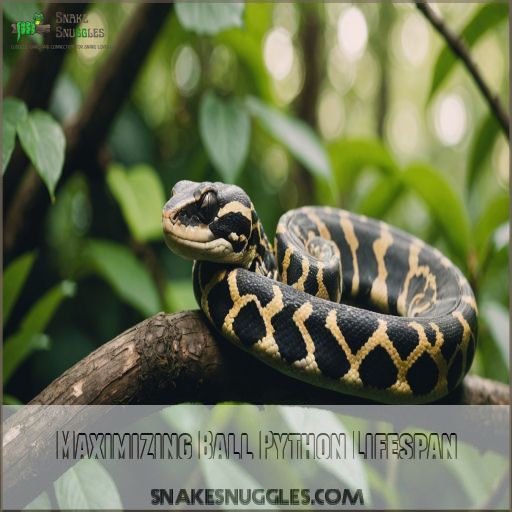This site is supported by our readers. We may earn a commission, at no cost to you, if you purchase through links.
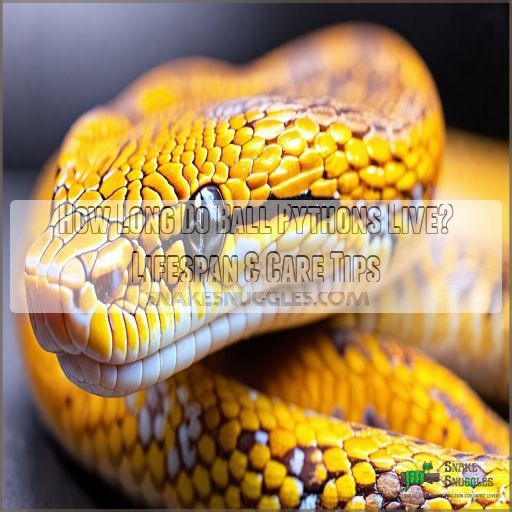
Of course, their longevity depends on factors like diet, habitat, and veterinary care.
As a responsible owner, you’ll need to provide your ball python with the perfect temperature, humidity, and hiding spots to help it thrive.
And don’t forget regular check-ups – those annual vet visits can go a long way in keeping your slithery friend healthy and happy for decades to come.
With the right care, your ball python could be your lifelong companion.
Intrigued? Let’s dive deeper into the secrets of ball python longevity!
Table Of Contents
- Key Takeaways
- Ball Python Lifespan Overview
- Average Ball Python Size & Length
- Ball Python Care and Longevity
- Ideal Habitat Setup for Longevity
- Temperature and Lighting Requirements
- Humidity and Water Requirements
- Diet and Nutrition for Longevity
- Common Health Issues and Prevention
- Handling and Stress Reduction
- Maximizing Ball Python Lifespan
- Frequently Asked Questions (FAQs)
- How long does a ball python last?
- How long do ball pythons live in captivity?
- Are ball pythons small?
- How old are ball pythons?
- How long do ball pythons live as pets?
- Does a ball python bite hurt?
- Do ball pythons like to be held?
- How big is a 30 year old ball python?
- Can ball pythons recognize their owners?
- Do ball pythons require social interaction?
- How often should ball pythons be exercised?
- Are there signs of a happy ball python?
- What are signs of aging in ball pythons?
- Conclusion
Key Takeaways
- You’ll find that ball pythons in captivity can live between 20 to 30 years if cared for properly, with some even reaching up to 40 years.
- Keep your ball python healthy with a balanced diet of appropriately sized prey, regular vet check-ups, and a clean, well-maintained environment.
- To create a happy home, maintain a proper temperature and humidity gradient in the enclosure and include cozy hiding spots.
- Regular handling helps reduce stress and builds trust, ensuring your ball python stays comfortable and relaxed.
Ball Python Lifespan Overview
You’ll be pleased to know that with the right care, your ball python can live for 20 to 30 years in captivity, and sometimes even longer.
Ball pythons in the wild don’t celebrate as many birthdays, with lifespans around 10 years due to various natural threats.
Captive Life Expectancy
In captivity, ball pythons boast a long life expectancy, typically 20 to 30 years, with occasional record-breakers reaching 48 years.
Genetics and breeding also play significant roles, much like a well-tuned formula one car engine.
Factors influencing lifespan include diet’s impact, stress, and longevity.
Regular wellness exams help them stay healthy throughout life.
Wild Life Expectancy
You might be surprised to learn that in the wild, ball pythons usually live around 10 years. Their wild existence is a survival show filled with:
- Predator impact lurking behind every bush
- Habitat threats disrupting their peaceful sunbathing
- Disease prevalence like respiratory infections causing troubles
- They thrive in natural savannah habitats, which can greatly affect their lifespan.
These elements shape their wild journey with unexpected twists and turns.
Factors Affecting Lifespan
While in the wild, ball pythons face numerous challenges.
Their lifespan can be influenced by several key factors.
Stress from improper environment, breeding habits impacting health, and diet choices all play a role.
Ensuring a proper habitat and balanced diet can prevent many health issues.
Understanding these factors helps you answer, "How long do ball pythons live?
Genetics and Longevity
Genetics play a key role in determining a ball python’s lifespan.
Selective breeding programs aim to produce snakes with desirable traits, including longevity.
However, inherited diseases can shorten a snake’s life.
While ball pythons are known to thrive in well-ventilated enclosures with proper temperature control and a thermal gradient, which can be achieved by using a heating pad, lifespan variation exists, proper care and nutrition help maximize your ball python’s chances of reaching their full potential of 20-30 years.
Average Ball Python Size & Length
You might be surprised to know that when fully grown, female ball pythons typically reach 3-5 feet, while their male counterparts stay a bit shorter at 2-3 feet.
These charming constrictors don’t grow overnight; rather, they develop gradually over a few years, reminding us that even in the snake world, patience is a virtue!
Female Ball Python Size
Think of a female ball python as a heavyweight champion.
On average, these ladies stretch between 3 to 5 feet long, weighing 2.5 to 5.5 pounds, typically larger than males.
A reliable growth chart helps you track age versus size.
They reach their breeding size after a few years, adding some intriguing dynamics to your python care journey.
Male Ball Python Size
In terms of male ball pythons, they usually measure between 2.5 to 3.5 feet long, making them more compact than females—it’s like comparing a cozy sofa to a king-sized bed!
Their stocky build is charming, and with proper handling, they’re easy to manage.
Who wouldn’t want a pet that fits just right? .
Growth Rate and Development
Ball pythons don’t grow overnight, which might keep your pet feeling like a forever friend.
Juveniles start at 10-16 inches, while adults range from 2 to 5 feet, with females usually larger than males (Source).
To track growth:
- Monitor hatchling size.
- Understand growth stages.
- Consider growth rate factors.
- Expect adult size variations.
Ball Python Care and Longevity
Caring properly for your ball python can greatly boost its chances of living a long, healthy life, possibly reaching 30 years or more.
Providing the right environment with controlled temperature and humidity, a balanced diet, and regular vet visits can keep your snake slithering happily, without the stress of more than the usual escape attempts.
Proper Housing and Enclosure
Choosing the right enclosure size for your ball python is key, considering the ideal setup should be at least as long as the snake and one-third its length in width, as discussed in the ball python habitat setup guide. For a ball python’s optimal growth and well-being, considering their age and size when choosing an enclosure is crucial, as hatchlings and juveniles require specific enclosures based on their development stage. Choosing the right enclosure size for your ball python is key.
You’ll want a space that’s about two-thirds their length.
Use newspaper or reptile carpet for substrate—it’s easy to clean!
Add cozy hiding spots to make your python feel secure, and prioritize good ventilation.
Decor choices like branches can enhance their environment while providing exercise and fun (Source).
Temperature and Humidity Control
Maintaining the right temperature and humidity levels is important for your ball python’s health and longevity.
Aim for a warm side of 80-85°F and a cool side of 75-80°F, with a basking spot of 88-92°F.
Keep humidity between 50-60%, misting as needed to prevent respiratory issues or scale rot.
Proper climate control helps your scaly friend thrive.
Feeding and Nutrition
Feeding your ball python properly goes beyond just temperature and humidity control.
Offer a variety of prey types, focusing on rodents sized appropriately for your snake’s age.
Frozen prey is safer than live, reducing injury risk.
For the best nutrition, consider gut loading prey before offering it.
This approach, along with correct feeding frequency, guarantees a healthy, long-lived snake.
Regular Veterinary Check-Ups
For regular veterinary check-ups, monitoring your ball python’s weight and feeding schedule is crucial, as some captive ball pythons can remain healthy when fed just once per month, make sure your ball python’s health is on the fast track to longevity! Focus on:
- Preventative care: like annual exams.
- Disease diagnosis: catch issues early.
- Parasite control: guarantee a clean bill of health.
- Health monitoring: track any changes.
These treatment options help keep your snake in the pink, not green around the gills!
Ideal Habitat Setup for Longevity
Creating the perfect habitat for your ball python is like setting up a cozy home that promises a long, happy life—think of it as designing a luxury resort for your scaly friend.
Choose the right enclosure size, cozy substrates, and perfect temperature gradients to keep your python not just surviving, but thriving.
Enclosure Size and Type
Creating the right home for your ball python is all about balance—like finding the perfect shoe size! Aim for an enclosure that matches your snake’s length, ensuring comfort and room to roam. Consider secure ventilation and sturdy tank types for longevity. A tight click of a lid means you won’t be surprised by a slithery escapee!
| Enclosure Size | Tank Types | Ventilation |
|---|---|---|
| Hatchlings: 10 gal | Glass | Screen lids |
| Juveniles: 20 gal | PVC | Mesh tops |
| Adults: 40+ gal | Acrylic | Lock systems |
Substrate and Decorations
A cozy ball python habitat requires the right substrate types and eye-catching decorations.
Choose natural materials like aspen or coconut husk for substrate, offering safety and comfort.
Spruce up enclosure aesthetics with sturdy, artificial foliage to avoid snake-induced plant carnage.
Engage your snake’s curiosity with DIY options like climbing rocks or tunnels.
Remember, a vibrant home means a happy python!
Hiding Spots and Security
Just like choosing the perfect couch for yourself, selecting the right hiding spots in your python’s enclosure is key to their comfort and longevity.
Offering different types of hiding spots provides security benefits and reduces stress.
Consider logs or rock crevices.
These additions mimic natural settings and protect your snake from potential "predators" like that ominous living room lamp!
Temperature Gradient and Lighting
Maintaining the right temperature gradient and lighting is essential for your ball python’s health and longevity.
Basking spot temperatures should be 95-104°F.
A warm hide should be 86-90°F.
A cool hide should be 72-80°F.
At night, temperatures should drop to 70-78°F.
Use a mix of heat lamps, ceramic heaters, and UVB lighting to recreate their natural environment.
Temperature and Lighting Requirements
When you’re setting up the perfect home for your ball python, getting the temperature and lighting just right is essential for their happiness and health.
Think of it as building a cozy mini-vacation spot for your snake, with warm basking areas and gentle nighttime lighting that guarantees they can relax and be their snakey best.
Temperature Gradient and Basking Spot
Think of your ball python’s enclosure like a cozy apartment.
The heat lamp should mimic the sun, providing a good basking temperature of 88-92°F in a space that’s big enough for lounging.
A thermal gradient setup, with a cooler side at 75-80°F, lets your snake choose where to chill, ensuring a comfortable home life.
Nighttime Temperature and Lighting
While maintaining a temperature gradient is key during the day, don’t forget that ball pythons also appreciate cooler nights.
Aim for a nighttime temperature of 70-78°F to support their nocturnal behaviors.
Using red lights can maintain heat without disrupting their natural light cycle, ensuring your snake feels safe and cozy all night.
Just keep an eye on humidity!
Heating and Lighting Options
You might consider heat mat types to keep your ball python cozy, selecting the proper wattage to prevent overheating.
Pairing this with a heat lamp makes sure effective light cycle effects while maintaining heat lamp safety.
At night, opt for gentle lighting, allowing your snake to feel right at home while chilling in its nighttime lighting environment.
Humidity and Water Requirements
To keep your ball python happy and healthy, it’s essential to get its humidity and water needs just right.
Think of it like creating a mini tropical vacation for your snake, where misting helps maintain humidity levels between 40-60% and a fresh water dish is always available for drinking and the occasional luxurious soak.
Maintaining Humidity Levels
Temperature and lighting set the stage, but maintaining humidity levels keeps your ball python in its comfort zone.
Aim for 60-70% using a hygrometer for accuracy.
Increase misting frequency during shedding periods.
Consider these tactics to balance humidity:
- Use appropriate substrate choice.
- Monitor enclosure ventilation.
- Adjust water dish size.
- Install a humid hide.
- Avoid hand cramps with a pressure sprayer.
Water Dish and Soaking Area
The size of your ball python’s water dish is really important.
Aim for a dish large enough for your snake to soak in comfortably.
Soaking can help regulate humidity and provide hydration benefits.
Check the water quality regularly and make sure the dish is placed in a low-traffic area.
Soaking can be a great way to keep your pet healthy and happy!
Misting and Hydration
After setting up that perfect soaking area, keep your ball python happily hydrated with proper misting.
Aim for a misting frequency that maintains humidity levels around 50-60%, but ideally between 60-80% best humidity levels for their overall health.
Use room-temperature water to avoid temperature shock.
Watch for dehydration signs like wrinkled skin.
A small water dish can supplement humidity control, ensuring your scaly friend stays comfy and content.
Happy misting!
Diet and Nutrition for Longevity
To make sure your ball python enjoys a long and healthy life, you’ll need to master the art of feeding it properly.
Focus on providing appropriately sized prey like mice or rats and maintain a feeding schedule that matches its growth needs.
Considering the cobra-free vibes you want to keep, supplements may not be necessary!
Prey Size and Type
Water management can be a slippery slope, right?
Let’s chat about prey.
Feeding your ball python the right size and type helps with happy digestion.
Here’s what to remember:
- Size Matters: Choose prey equal to the widest part of your snake’s body.
- Variety is Key: Mix up rats, mice, or even birds.
- Shop Smart: Opt for quality sources to avoid health issues.
Feeding Schedule and Frequency
You’ve figured out the right prey size; now let’s talk meal frequency.
For juveniles, feed once a week to support growth.
Adults enjoy their meals less often, about every 1-2 weeks.
Don’t worry if they fast occasionally—it’s normal.
Keep an eye on their weight for peace of mind.
Just think of fasting as their version of a diet!
Supplements and Vitamins
Ensuring your ball python thrives, supplements come into play despite whole prey meeting most nutritional needs.
Lightly dust prey with a calcium and multivitamin blend to tackle potential vitamin deficiencies and enhance gut health.
Choose reputable supplement brands, and consider UVB lighting for D3 synthesis.
After all, a pampered python is a happy python!
Common Health Issues and Prevention
Keeping your ball python healthy isn’t just about feeding it right; understanding common health issues like mouth rot and respiratory infections is key to prevention.
By staying alert to symptoms and maintaining ideal habitat conditions, you can make sure your slithery friend lives a long, happy life without regular visits to Dr. Snake, the reptile vet.
Mouth Rot and Scale Rot
Mouth rot and scale rot are two nasty conditions that can plague your ball python.
Poor enclosure hygiene and weakened immunity often trigger these infections.
Look for signs like swelling, discharge, and foul odors.
Treat promptly with antibiotics and topical meds, and keep that habitat spotless to prevent future flare-ups.
Respiratory Infections
Respiratory infections in ball pythons can be a serious concern, particularly if humidity levels are not properly managed, as outlined in the ball python good pet care guide, but keeping an eye on signs like nasal discharge and wheezing helps.
Causes include bacteria, like bacterial infections, and improper humidity levels.
Treat infections with antibiotics and make sure a cozy, humid habitat for prevention.
Maintain a balanced environment, and your slithery friend will breathe easy.
Parasites and Mites
Spotting parasites and mites on your ball python can feel like a horror movie, but don’t panic!
Keep an eye out for common symptoms like lethargy, rubbing, or tiny black dots, which indicate mites or other parasites.
Regular skin checks and maintaining a clean habitat are key steps in parasite prevention and mite identification in your snake’s enclosure.
Prevention and Treatment
Dealing with mites can feel like a real snake in the grass, but keeping your ball python healthy is manageable.
Focus on prevention and treatment for common health issues:
- Parasite Prevention: Keep the habitat clean and monitor regularly.
- Scale Rot Treatment: Use a vet-recommended antiseptic.
- Respiratory Infection: Improve air quality.
- Mouth Rot Treatment: Seek veterinary advice promptly.
Handling and Stress Reduction
When handling your ball python, you’ll want to be gentle and patient, as this helps reduce stress and builds trust between you and your scaly companion.
Think of it as making a new friend—give them space, get comfortable, and before you know it, even your most anxious slither buddy will be content in your company!
Handling Techniques and Tips
Providing ample hiding places, like hide boxes for security, helps reduce stress and promotes security when handling your ball python gently is key to building trust.
Approach the enclosure calmly, and let your snake wrap around your arm for secure support—think of yourself as their trusty branch.
Avoid quick movements; they’re not auditioning for the next action film!
Remember, a calm hold equals safe restraint, fostering responsible interaction and stress reduction.
Stress Reduction and Minimization
Imagine easing your ball python’s anxiety by reducing stress effectively.
Ball pythons are generally perceived as docile, but may exhibit defensive behaviors when stressed, making gentle handling essential in establishing trust, as seen in comparisons with other species like the rosy boa vs ball python.
You can make a world of difference with:
- Gentle Handling: Limit handling sessions to short, calm encounters. Your snake will appreciate it!
- Quiet Habitat: Minimize loud sounds and sudden movements around their enclosure.
- Consistent Routine: Keep a steady feeding and lighting schedule to make them feel secure and relaxed.
Environmental Enrichment
To keep your ball python thriving, you’ll want to provide plenty of environmental enrichment.
Incorporate natural cage decor like branches, rocks, and plants to encourage their instinctive behaviors.
Offer opportunities for social play and mental stimulation through puzzle feeders or rotating new items.
With a bit of creativity, you can create a habitat that keeps your scaly friend engaged and content.
Maximizing Ball Python Lifespan
To keep your ball python living the longest and happiest life possible, focus on providing proper nutrition, regular veterinary care, and a clean, safe environment.
Just like choosing the right genes in a video game character, selecting healthy breeding lines can also set your scaly friend up for success.
Regular Veterinary Care
Preventative care for your ball python involves regular veterinary visits.
An annual checkup is like a health report card, ensuring everything’s A-okay!
Vets can spot issues early, provide parasite control, and perform health screenings key for disease prevention.
Remember, you can’t teach a snake tricks, but you can keep it healthy and thriving for years to come.
Proper Nutrition and Hydration
Keep your ball python in tip-top shape by diving into proper nutrition and hydration techniques.
Make sure the water dish is large enough for soaking and replenished daily.
Hydrate them frequently.
Offer a colorful menu of prey, remembering prey size matters!
Sprinkle dietary supplements like calcium on meals for good measure.
And voilà, you’ll nurture a happy, long-living snake.
Clean and Safe Environment
A clean and safe environment works wonders for your ball python’s well-being.
You’ve mastered nutrition, now focus on enclosure hygiene, starting with the right enclosure size – a minimum of 48" x 24" x 24" for adults, as discussed in the ball python enclosure setup.
Regular cleaning reduces stress and prevents parasites.
Don’t forget these essentials:
- Choose proper substrate types.
- Practice spot cleaning.
- Maintain good ventilation.
- Provide stress reduction with secure hides.
- Make sure you have parasite prevention with routine checks.
Happy snake, happy life!
Genetic Selection and Breeding
When you’re considering genetic selection and breeding for ball pythons, think about juggling genetic diversity while ticking off morphs and health. Female ball pythons typically reach reproductive maturity at 27 to 31 months of age, so consider this age range when selecting breeding stock.
Avoid inbreeding risks like the plague; they can lead to unfortunate complications.
Selective breeding is your ally, but always remember ethical considerations.
After all, we’re not just breeding snakes, we’re preserving their charm and health.
Frequently Asked Questions (FAQs)
How long does a ball python last?
Expect your ball python buddy to stick around for 20 to 30 years with proper care.
In captivity, they can thrive even longer, sometimes reaching 40 years, outlasting some marriages!
How’s that for a lifelong companion? .
How long do ball pythons live in captivity?
Ball pythons can live 20-30 years in captivity, with some reaching 40 years or more.
Companionship
With a bit of TLC, you’ll enjoy a long companionship—longer than many adventures in the wild west!
Are ball pythons small?
You’re probably wondering how big they can get and how long it takes for them to grow, with some ball pythons reaching sizes of up to 6 feet long. You’re curious about ball pythons’ size.
They’re the smallest African pythons, typically growing 3-5 feet long and weighing up to 20 pounds.
This makes them a popular pet choice due to their manageable size.
How old are ball pythons?
When estimating your ball python’s age, consider that they reach adulthood at 16-18 months as discussed in Ball Python Age Estimation. You might wonder about your ball python’s age.
Typically, they reach full size around 3-5 years.
Each grows at its own pace, influenced by genetics and environment, so focus on its health over specific age standards.
How long do ball pythons live as pets?
Captive ball pythons can live an impressive 20-30 years, far outliving their wild counterparts. With proper care and a dedicated owner, these friendly snakes make wonderful lifelong companions.
Does a ball python bite hurt?
Feeling a ball python’s bite generally resembles tiny pinpricks—nothing to lose sleep over.
Their bites are rare and not severe, often due to handling without care.
So, no need to fear; just handle them gently.
Do ball pythons like to be held?
Holding a ball python is like winning their cautious trust.
They’re shy, often preferring solitude over snuggles.
While they mightn’t enjoy being held, regular handling helps them feel comfortable during necessary moments like vet visits or cleaning.
How big is a 30 year old ball python?
A 30-year-old ball python won’t tower over you like a skyscraper but expect females to reach around 4-5 feet, with males staying closer to 2-3 feet.
Longevity!
Remember, they’re lifelong companions with impressive longevity!
Can ball pythons recognize their owners?
Ball pythons recognize their owners by scent rather than sight.
They don’t form bonds like dogs.
They associate your smell with safety and comfort, making them more relaxed in your presence.
Do ball pythons require social interaction?
Your ball python doesn’t need socialization like a dog does, but regular handling keeps it tame and offers exercise benefits.
Think of yourself as a tree—it’s more about stability than forging deep friendships.
How often should ball pythons be exercised?
Provide your ball python with a large enclosure for exercise and mental stimulation.
Regularly handle it, let it climb, and offer live prey feeding to keep it active.
Maintain proper humidity levels to support its health.
Are there signs of a happy ball python?
A happy ball python will explore its surroundings slowly, flick its tongue casually, and have a relaxed grip.
You might even catch it enjoying a little nap after a hearty meal, the reptile version of a food coma.
What are signs of aging in ball pythons?
Spotting signs of aging in ball pythons is like finding gray hairs; subtle yet telling.
Look for muscle loss, broader heads, or fatty lumps.
Keep track—it’s all in the details for these gentle giants (Source).
Conclusion
Imagine caring for a plant that could thrive for decades—your ball python’s longevity is similar with attentive care.
With proper diet, habitat, and regular vet check-ups, these snakes can live up to 30 years.
Providing the right environment, including temperature and humidity, makes sure your ball python remains your slithering companion for years.
So, gear up to give your scaly friend the best life possible, and you’ll both enjoy a long, happy journey together.
How long do ball pythons live? Now you know!

